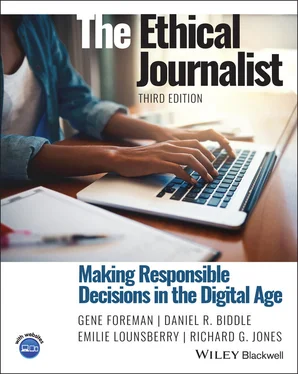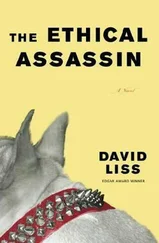Gene Foreman - The Ethical Journalist
Здесь есть возможность читать онлайн «Gene Foreman - The Ethical Journalist» — ознакомительный отрывок электронной книги совершенно бесплатно, а после прочтения отрывка купить полную версию. В некоторых случаях можно слушать аудио, скачать через торрент в формате fb2 и присутствует краткое содержание. Жанр: unrecognised, на английском языке. Описание произведения, (предисловие) а так же отзывы посетителей доступны на портале библиотеки ЛибКат.
- Название:The Ethical Journalist
- Автор:
- Жанр:
- Год:неизвестен
- ISBN:нет данных
- Рейтинг книги:5 / 5. Голосов: 1
-
Избранное:Добавить в избранное
- Отзывы:
-
Ваша оценка:
- 100
- 1
- 2
- 3
- 4
- 5
The Ethical Journalist: краткое содержание, описание и аннотация
Предлагаем к чтению аннотацию, описание, краткое содержание или предисловие (зависит от того, что написал сам автор книги «The Ethical Journalist»). Если вы не нашли необходимую информацию о книге — напишите в комментариях, мы постараемся отыскать её.
Praise for the Third Edition of The Ethical Journalist
ANN MARIE LIPINSKI,
Praise for the Earlier Editions
GENE ROBERTS,
ALICIA C. SHEPARD, The Ethical Journalist
The Ethical Journalist
The Ethical Journalist — читать онлайн ознакомительный отрывок
Ниже представлен текст книги, разбитый по страницам. Система сохранения места последней прочитанной страницы, позволяет с удобством читать онлайн бесплатно книгу «The Ethical Journalist», без необходимости каждый раз заново искать на чём Вы остановились. Поставьте закладку, и сможете в любой момент перейти на страницу, на которой закончили чтение.
Интервал:
Закладка:
Because a conflict of interest gives the audience reason to doubt the journalist’s loyalty, it undermines credibility.
An appearance of a conflict of interest can damage credibility even if the journalist’s reporting is honest.
By following reasonable guidelines, you can avoid most conflicts, actual or apparent.
Identifying situations that commonly lead to conflicts.
Case Study: A Reporter’s Son Joins a Foreign Army
Case Study: A Journalist’s Gifts to the Clinton Foundation
Case Study: The Columnist’s Other Job
Case Study: Carrying a Torch, Stirring Debate
13 Lifting the Curtain on How Journalism Is Done
SPJ’s guiding principle of being accountable and transparent
News organizations should correct their mistakes promptly, prominently, and clearly.
News organizations should have a system to invite, receive, and act on inquiries and complaints about news coverage.
News organizations should be willing to explain and discuss how they cover the news.
The audience can be a partner in reporting the news, but journalists have a duty to verify all user-generated content.
There are limits to journalistic transparency, including the question of whether reporter’s personal opinions should be revealed.
Point of View: A Digital Dialogue With Readers ( Mark Bowden )
Case Study: Roughed Up at Recess
14 Navigating Social Medias Uneven Terrain
Connecting with the audience while maintaining impartiality
Using social media helps journalists report their stories and promote them. However, journalist’s comments about people and events in the news can damage their credibility and that of their news organizations.
Social media policies are a common source of tension in newsrooms, and enforcement of those policies has led to staff protests.
Point of View: Race, Gender, Social Media, and Power ( Ingrid Sturgis )
Point of View: A Journalist’s Duty (Bob Steele)
Case Study: A Reporter’s Tweet Hits a Sour Note
15 Covering a Diverse, Multicultural Society
An ethical duty to be inclusive in news coverage and in the newsroom
Covering society’s diversity is an ethical responsibility, because news organizations have a duty to cover the entire community.
Careful, sensitive reporting is required to analyze the complex issues of racial and ethnic conflicts.
Journalists face challenges in their efforts to provide knowledgeable coverage of cultures other than their own.
Reporters who cover new immigrants are confronting ethics issues such as protecting the identity of sources who are not documented.
Point of View: Gaining Respect by Showing Respect (Joann Byrd)
16 Dealing With Sources of Information
The fine line between getting close and too close
Ethics issues arise in reporter’s efforts to cultivate sources while maintaining independence from those sources.
If a journalist agrees to protect a source who provides information on condition of anonymity, honoring that agreement is a solemn ethical duty.
Journalists must avoid placing their sources in any kind of jeopardy.
Beat reporting requires reporters to balance their relationships with newsmakers whom they depend on for information but also may have to report on critically.
Showing copy to sources and other situations in which ethics issues arise in source relationships.
Point of View: Sometimes, Different Rules Apply ( Jeffrey Fleishman )
Case Study: The Strange Intercept at “The Intercept”
17 Making News Decisions About Privacy
The public may need to know what individuals want hidden
Journalists often must decide between the publics legitimate need to have certain information and the desire for privacy by the individuals involved.
Although there are certain legal restraints on publicizing private information, most decisions are made on the basis of ethics rather than law.
A three-step template, weighing the value of the information to the public against the degree of harm to the subject, can aid decision-making in privacy cases.
Reporting situations in which privacy is central to decision-making.
Case Study: Tracing the Source of Web Comments
Case Study: Identifying a 13-Year-Old Rape Victim
18 Making Decisions About Offensive Content
The conflict between reflecting reality and respecting the audience
Journalists often have to decide whether to publish or broadcast content that could offend a significant element of the audience.
Offensive content falls into three categories: perceived insensitivity, offensive words, and offensive images.
A two-step process can help you make decisions, weighing the content’s news value against how offensive it is.
Although the internet empowers the audience to be heard, news organizations are struggling to find ways to curb incivility, and some are discontinuing online comments.
Case Study: A Vulgar List in the News
Case Study: A Killer Records a Video of His Murders
19 Deception: A Risky, Controversial Tool
When values collide: Lying while seeking the truth
To decide whether to use a deceptive reporting practice, you first must acknowledge the deceit and not rationalize it.
Before engaging in undercover reporting - pretending to be someone else you must meet exacting standards.
There are other situations, short of undercover, in which journalists could deceive or could be perceived as deceiving.
There is a consensus in the profession that a journalist should never deceive the audience or the journalists colleagues.
Point of View: The Truth About Deception ( Brooke Kroeger )
Case Study: Rumsfeld’s Q&A With the Troops
Case Study: Spying on the Mayor in a Chat Room
20 Ethics Issues in Visual and Audio Journalism
Seeking truth with the camera or microphone while minimizing harm
The public, aware how easy digital manipulation can be, must be able to trust the truthfulness of the news media’s photography and audio reports.
News organizations have adopted standards to ensure the integrity of their photography and audio reports.
The success of podcasts has created a new opportunity for audio journalism where ethics standards are still being formulated.
Recognizing that some news photography can offend the audience, journalists weigh its news value against the likely offense.
A number of news organizations are reducing their use of police arrest portraits because of fairness concerns.
The use of aerial drones for news photography is increasing, and ethics guidelines are being put in place to protect privacy and safety.
Case Study: The Falling Man, World Trade Center, 2001
Case Study: Photographing a Man Pushed to His Death
21 Stolen Words and Invented Facts
Dishonesty can kill a career in journalism
Plagiarism and fabrication are morally wrong. Plagiarism is stealing the creative work of another. Fabrication is making things up and presenting them as fact.
The offenses of plagiarism and fabrication destroy journalism’s credibility and cost offenders their jobs and their careers.
Committing illegal acts is unacceptable in the pursuit of news.
Following sound work practices can help you avoid any hint of impropriety.
Newsroom leaders have a duty to establish clear rules about journalistic misconduct and to enforce them.
22 The Business of Producing Journalism
Seeking financial stability in a turbulent era of transition
Читать дальшеИнтервал:
Закладка:
Похожие книги на «The Ethical Journalist»
Представляем Вашему вниманию похожие книги на «The Ethical Journalist» списком для выбора. Мы отобрали схожую по названию и смыслу литературу в надежде предоставить читателям больше вариантов отыскать новые, интересные, ещё непрочитанные произведения.
Обсуждение, отзывы о книге «The Ethical Journalist» и просто собственные мнения читателей. Оставьте ваши комментарии, напишите, что Вы думаете о произведении, его смысле или главных героях. Укажите что конкретно понравилось, а что нет, и почему Вы так считаете.











